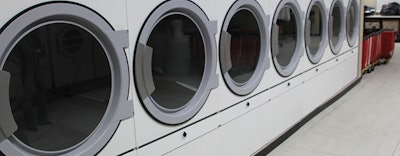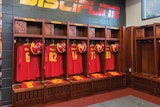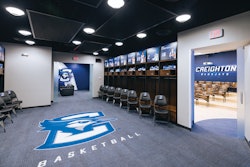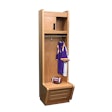
Working in an athletic laundry facility is a complicated job. Anyone working in such an environment can attest to the headache caused just by athletic uniforms, which have become anything but uniform. "You probably have five different materials on a typical athletic uniform now," says Bill Brooks, North American sales manager for Ripon, Wis.-based UniMac. "I've been dealing with an NFL uniform with five different fabrics. To get paint out of a uniform with five different fabrics requires a complicated wash cycle and chemical needs."
On top of that, equipment managers need to track and process myriad loads of towels, workout clothes and other gear as efficiently as possible to ensure athletes and teams have access to everything they need when they need it. It's no surprise, then, that sometimes things such as environmental efficiency fall through cracks. "It's so common that their processes are not as good as they could be," Brooks says. "A majority of laundry rooms could easily make improvements to save not only resources, but time and money."
As with any other industry, the technology used in athletic laundries continues to evolve, allowing for greater efficiencies, not just for time- and money-saving, but environmental sustainability, as well. Here are three areas in which athletic equipment managers and others working in laundry operations might look to become more eco-friendly:
AQUATIC PROGRAM
Reducing water consumption is a top objective for any sustainability initiative, and laundries naturally present great challenges and opportunities in terms of water conservation. Modern laundry systems have been finely tuned to do the best possible job with the least amount of human interaction. "Choose highly efficient washers and dryers, and choose highly programmable washers," says Steve Leib, national sales director with Oshkosh, Wis.-based Sports Laundry Systems. "Once individual programs are set up for cleaning towels, uniforms, loops and practice gear, users just load the washer, select the appropriate program number and press start. This reduces human error."
"One of the best ways to reduce water use is to use programmable-control machines with a choice of water levels," says Gary Gauthier, regional sales manager with Kenner, La.-based Pellerin Milnor Corporation. "This allows the machine to employ an appropriate amount of water for the goods that are being processed."
Using the right settings doesn't always mean that water and other resources are being used most efficiently, though. Gauthier cautions that underloading machines is all too common a practice in laundry operations. "This practice wastes water, chemicals, energy and time," he says. "An easy way to reduce the environmental impact of the laundry is to reduce the overall number of laundry loads by properly filling the machine. As a rule of thumb, I encourage that frontloading washer-extractors be filled until there's a football-sized opening at the top of the basket."
Automated control systems have a huge impact on operational efficiency, but for those looking to go even greener, there are other options, such as UniMac's OPTispray rinse feature, which Brooks describes as "a shower rinse instead of a bath rinse, essentially."
Taking it one step further is United Kingdom-based Xeros Technology, a relative newcomer to the U.S. commercial laundry market, whose systems use polymer beads in place of a majority of the water used during cleaning, reducing water consumption and, consequently drying time and energy.
Operators may also consider adding a water-reclamation system to their equipment, suggests Leib, which takes the graywater created during a wash or rinse cycle and processes it for reuse. "A system can be added at the time of order, or added to many washer units after installation," he says. "On average, water reclamation can save up to 40 percent of rinse water used for prewash and wash baths."
RELATED:
Keeping College Athletic Laundry Operations Running Smoothly
Maximize Laundry Efficiency by Eliminating Human Element from Drying Process
Ozone Finding Its Place Within the On-Premise Laundry Industry
STUCK ON AUTOPILOT
Like any other environment, an equipment room is constantly changing, and those changes can affect the efficiency of laundry equipment — maybe new uniforms with different fabrics or a different style of towel are purchased, or maybe the actual practices of the athletic equipment managers simply don't mesh with the original expectations when the equipment was programmed. "One thing we find is that once something is set up, it just repeats for a decade," warns Brooks. "The staff will run the same cycles until the machine fails — for 10 years, you might run wasteful cycles."
Operational efficiency should be reviewed on a regular basis. A new platform from Unimac offers a tracking dashboard that allows behavior to be monitored and adjusted. "When you're sending the data up to the cloud, anyone with the authority to view that data — the distributor, owner, us at the factory — we're trying to build data that compares like businesses and figure out best practices," says Brooks. "Let's say you're working with towels. We can look at the towel load itself and determine how much water is used per load. You can drill down and look at the cycle settings. It doesn't have to be the person onsite, you can have an expert come in and look at it and say, 'Wow, they're doing high-level fills multiple times, and they don't need to be doing that.' "
THE RIGHT CHEMISTRY
Energy-efficient laundry equipment can go a long way toward reducing environmental impact, but advances in chemicals are also playing an important role. "There are a range of cold-water chemistries on the market that can effectively clean textiles while using less heated water," says Gauthier, which can contribute to a significant decrease in energy usage.
"Chemical companies have done a lot with cold-water washing," Brooks adds. "It hasn't been around forever, but it's become much more popular in the last two years. Probably no one running operations now looks back and asks if they should consider a cold-water wash."
In the past few years, the use of ozone has become more common in laundry operations, as the technology becomes more reliable and users become more familiar with its potential. "The use of ozone greatly lessens the amount of other chemicals needed to properly clean athletic laundry," Leib says. "And unlike chlorine bleach, ozone isn't a harsh chemical. It disappears as it cleans. It also loosens fibers, resulting in fluffier, cleaner items."
The increased efficiency provided by ozone can result in less water consumption and shorter overall wash times, says Leib, also noting advancements in ozone-injection-system technology that provide even more precision. "The ability to automatically adjust ozone levels to ensure laundry disinfection is relatively new to athletic laundries," he says. "A variable ozone system automatically adjusts the ozone generator output to match each specific load according to the load size and soil content — more ozone is needed for larger, heavily soiled loads."
Finally, a good working relationship with your chemical representatives can help keep equipment managers on top of the latest best practices, helping remove some of the headache caused by complicated uniforms while maintaining efficiency. "Laundry chemistry has become more specialized through the years and newer products are capable of doing more with today's high-performance textiles," says Gauthier. "A knowledgeable chemical rep who can visit the laundry locally and solve cleaning issues is an ideal resource for any athletic facility."
ERR DRY
AB asked three laundry equipment representatives to share their most-commonly seen laundry operations errors. Is your facility guilty of any of these?
"The most common mistakes are either the length of the cycle or programming of the cycle itself — how many fills and what level of fill, how much time. We often find that athletic facilities will wash towels for worst-case scenario, like greasy towels. The program required for that is hot water, longer cycle, more chemicals, more rinses."
— Bill Brooks, UniMac
"The most common mistakes I see are chemical overuse and over-drying, both of which can result in costly damage to uniforms."
— Steve Leib, Sports Laundry Systems
"Underloading. Some people worry that putting too much into a washer is bad for the machine or that the goods won't get clean. Underloading a frontloader can cause out-of-balance extract cycles that will prematurely damage the bearings and frame of the machine. Always try to wash and dry full loads. That is what industrial-grade laundry machinery is designed to do."
— Gary Gauthier, Pellerin Milnor Corporation
This article originally appeared in the July/August 2015 issue of Athletic Business with the title "A CLEAN ENVIRONMENT"

































